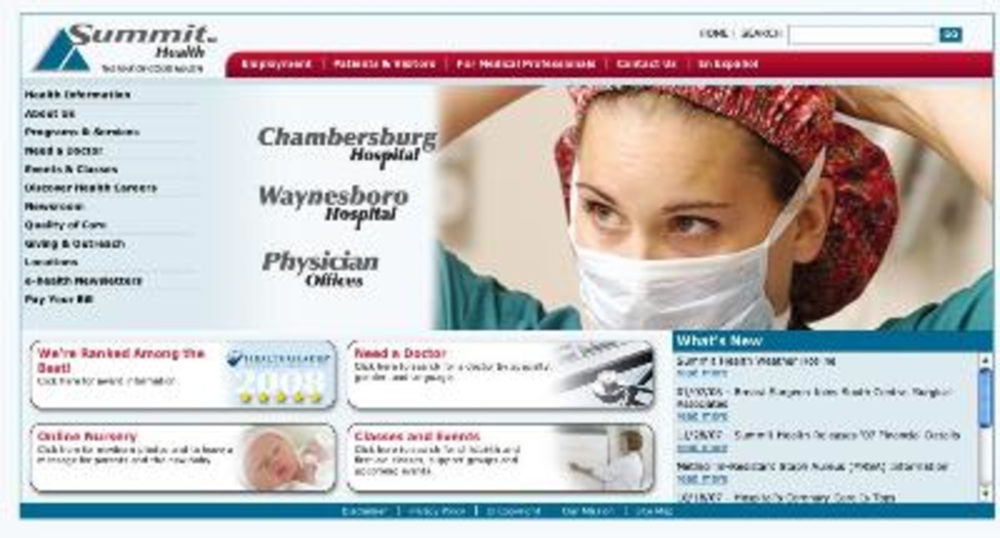As harsh as it may seem in this era of concern about a lack of health insurance coverage among many Americans, hospitals and medical centers are constantly looking to fill their beds with patients who have the kind of insurance that can pay for profitable specialty care. In order to survive and turn a profit, marketers need to attract paying patients — and many are doing so by communicating directly to the consumer in a positive, personal way.
More and more facilities are realizing the power of not just local, but also national exposure to meet these marketing goals, and online campaigns have proven a valuable asset in this mission — especially since many Americans consult the Internet before seeing a doctor.
However, while search engines and health information Web sites such as WebMD are valuable tools for mystified sufferers or concerned parents, they pose a challenge to medical centers that want to be top-of-mind when potential patients Google their ailments.
“In the past, you would go to the local hospital for any [illness] you had,” says Ken Delaney, VP at software company FatWire, which has worked with hospitals on their online efforts. “Now people are really doing the research [on their own] and are willing to get on planes and go to the right hospital.”
Search engine optimization helps hospitals get ranked better, Delaney adds, which enables them to sell higher-margin products such as support groups and other aftercare amenities.
Aftercare may be profitable, but one of the most significant healthcare marketing trends is the emphasis on hospitals’ role in wellness, casting a positive light and drawing attention well before a patient gets sick.
“With medical service advertising, the person has to think through a world where someone they know is ill,” says Dave Weaver, chief strategic officer at TM Advertising, which developed a wellness-focused branding campaign for Group Health Cooperative, a Seattle-based nonprofit care and coverage company. “There’s a real opportunity to reframe that and say it’s not about being sick, it’s about being healthy.” Innovative hospital branding efforts, he adds, have included feel-good features such as games, diet and fitness tips.
Still, medical centers have to retain an air of responsibility, trust and capability. “It’s a sensitive category. With life and death, you have to be careful emotionally,” says Steve McKee, president of McKee Wallwork Cleveland, which worked with Presbyterian Healthcare Services in New Mexico on a recent campaign promoting relaxation and happiness along with health. “But that doesn’t mean you can’t use happiness.”
Creativity is important in a field that has traditionally been very serious in its messaging, says McKee — due to regulations and the fact that the industry is so data-driven — but he adds that anything creatively different will get a reaction as long as it’s appropriate for the sector. For example, street teams have increased positive attention for medical centers with creative approaches and community involvement in marketing campaigns.
Though direct marketing efforts in various channels can fit into tight budgets, make hospital brands more approachable and communicate creative messages, ultimately marketers need to remember that branding extends to the overall experience at the facility. “A medical facility brand is not based on advertising,” says Weaver. “It is based on doctor interaction, how attendants act and the smiles on their faces.”
Presbyterian Healthcare Services: Web siteand viral campaign
Albuquerque, NM-based marketing agency McKee Wallwork Cleveland worked with PHS, a group of hospitals, clinics and treatment facilities on a branding campaign called “Feel Better.” The goal was to give people ‘what they need when they need it,’ whether it was detailed diseaseinformation, a helping hand or just a smile. Techniques included a Web site, as well as street teams holding doors open while handing out bottled water and lollipops with the campaign logo.
Summit Health: SEO and user-friendly features
FatWire and Element115 partnered to create a Web site for Pennsylvania-based Summit Health, the parent company of two hospitals. The site was loaded with information and useful features for patients. With their eHealth Accelerator product, the two technology companies added content customized for search engine optimization, news and bill payment. In addition, they created a content management system to allow non-tech savvy medical professionals to publish necessary Web pages and communicate directly with potential patients.
Group Health Cooperative: Branding campaign
TM Advertising decided to focus on health “dos” instead of “don’ts” in a branding campaign for Group Health Cooperative, which has medical facilities in Seattle and Idaho. Called “Find More Minutes,” the campaign featured a Web site and community outreach. It focuses on ways to increase lifespan and well-being with tips, doctor Q&As, games, forums and a Google Maps-based feature that helps locate hiking and biking trails.







